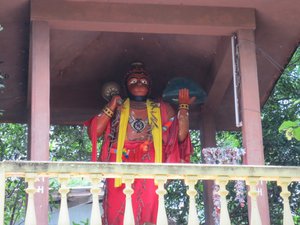Advertisement
Published: September 16th 2013

 Hanuman, the Hindu Monkey God
Hanuman, the Hindu Monkey God
This statue was erected on Rumasalla Peninsula in the hopes of ethnic peace in Sri Lanka, while the bloody civil war was still happening. Remembrance of things past:
Sri Lanka has just emerged from decades of civil war, causing the deaths of 100,000 or more citizens. On top of that, the 2004 tsunami killed over 30,000 in one day.
Wherever you look, there are reminders of the past and efforts underway for reconstruction.
Near the sea end of Rumasalla Peninsula, where we have been staying in the Glass House, there is a large statue of Hanuman, the Hindu Monkey God, erected during the civil war and dedicated to the hope for ethnic harmony in Sri Lanka.
Hanuman is connected to Rumasalla in the Hindu epic the
Ramayana. Many different versions exist about what Hanuman did, but one is that when Lakshman is severely wounded in the battle of Lanka, Hanuman is asked to get the medicinal herbs to cure him. He flies back to the Himalayas to get them, but either can't find them (one version) or can't remember what to get (another version) so he brings back the whole mountain. A couple pieces of it fall and one forms the Rumasalla Peninsula, and that is why these special medicinal herbs are found in only those two places outside of the

 Peace Pagoda
Peace Pagoda
Ships approaching Galle Harbour can see the Peace Pagoda perched high on the western side of the peninsula.Himalayas.
Just along the hillside from Hanuman is the beautiful Peace Pagoda, one of 5 built in Sri Lanka by Japanese Buddhists. It's a massive, smooth, gleaming, serene stupa which houses 4 statues of Buddha representing different stages in his life.
This area is actually a complex of monuments. There's also the memorial to the 2004 tsunami victims, the peace bell, and another building which appeared to have prayerful people in it, but which I didn't go near.
To the east of the peninsula is Unawatuna Beach which was demolished by the tsunami, but which is springing back into tourist business as fast as it can. There are many hotels, bars, restaurants, shops and guest houses already functioning, and more on the way. Crowds of backpackers and more well-heeled tourists range up and down.
Many of the buildings are being constructed right on the edge of the sand again. One wonders about the wisdom of this...
It leaves me pondering, How does one go forward after huge tragedies? Remembering or forgetting? Or cordoning off the memories and working around them?
Advertisement
Tot: 0.111s; Tpl: 0.015s; cc: 8; qc: 23; dbt: 0.0788s; 1; m:domysql w:travelblog (10.17.0.13); sld: 1;
; mem: 1.1mb

 Hanuman, the Hindu Monkey God
Hanuman, the Hindu Monkey God 
 Peace Pagoda
Peace Pagoda





































Michelle
non-member comment
Peace & love
Good to see the Peace Pagoda. Impossible to imagine what it must be like to loose so many people both in the civil war and tsunami. Great that you and Phil are enjoying the experience so much. M xx